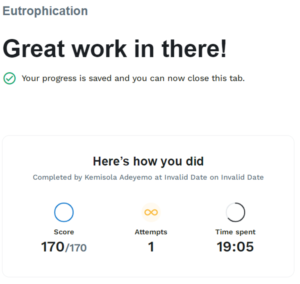COURSE
SCIE1046: Fundamentals Of Microbiology With Lab
1. About the Lab
Learning Objectives:
- Understand the nitrogen cycle and its importance for living beings.
- Understand the concept of eutrophication and harmful algal bloom, and the impact that it has on the ecosystem.
- Analyze dissolved nitrogen levels in the water sample.
- Understand the importance of sampling from different locations to get representative data.
Estimated Length: 30 to 35 minutes
MAKE THE CONNECTION
The background information in section 2 was adapted from the following Microbiology lecture course Tutorials:
2.2.3 Algae
3.2.4 Microbial Photosynthesis
3.2.5 Biogeochemical Cycles
2. Background Information
The following background information will be helpful as you prepare for the simulation.
2a. Introduction to Algae
Algae are autotrophic protists that can be unicellular or multicellular. The dinoflagellates, diatoms, golden algae, and brown algae are classified as TSAR (formerly within supergroup Chromalveolata). The red and green algae are classified under Archaeplastida. Algae are important ecologically, environmentally, and economically because they are responsible for the production of approximately 70% of the oxygen and organic matter in aquatic environments. They are at the base of many food webs. Some types of algae, even those that are microscopic, are regularly eaten by humans and other animals. Algae are also the source of agar, agarose, and carrageenan that are used as solidifying agents in the laboratory and in food production.
Although algae are not pathogenic, some species produce toxins. Algal blooms occur when algae grow quickly and produce dense populations. This can result in the release of large quantities of toxins that harm aquatic animals and humans. Additionally, the decomposition of these algae uses up oxygen and produces “dead zones” as organisms die in these zones from lack of oxygen.
TERM TO KNOW
This glossary term is important to know and will help you during the Activity.
Algal bloom
An overgrowth of algae that can be harmful because of the release of toxins or depletion of oxygen.
2b. Microbial Photosynthesis
Photosynthesis involves two major parts: the light reactions (also called light-dependent reactions) and the light-independent reactions (also called the Calvin cycle). The light reactions use light energy to produce the chemical energy to power light-independent reactions.
The table below summarizes the stages of photosynthesis in green plants, which will be explained in more detail below. Note that the light reactions produce ATP and NADPH that are used by light-independent reactions. Light-independent reactions then produce the molecules needed for light reactions to continue. Oxygen is released into the atmosphere and carbon dioxide is taken in from the atmosphere.
| Stages of Photosynthesis in Green Plants | |||
| Location | Inputs | Outputs | |
| Light reactions | Thylakoid membranes | Light energy, ADP, (inorganic phosphate), | ATP, NADPH, |
| Light-independent reactions | Stroma (eukaryotes) | , ATP, NADPH | ADP, , organic molecules |
The image below shows a simplified illustration of photosynthesis, indicating the inputs and outputs of each stage.
The image below illustrates the points in the table by showing where each step takes place in a chloroplast. Note that the light-independent reactions are labeled as “ fixation” because that is the first step of those reactions.
Thinking about all the ways in which humans rely on nitrogen makes it clear why the nitrogen cycle is so important. Humans need nitrogen and so do other living organisms that rely on proteins, nucleic acids, and other nitrogenous compounds.
Atmospheric nitrogen (N2) comprises 78% of atmospheric air, but it is not accessible to most organisms. Microbes play an essential role in converting nitrogen to forms that other organisms can use.
Many bacteria are capable of nitrogen fixation, which means that they can incorporate nitrogen into biomolecules. These include several major groups of free-living and symbiotic bacteria.
EXAMPLE
Cyanobacteria in aquatic ecosystems fix inorganic nitrogen from dissolved nitrogen gas (N2) into ammonia (NH3), which is readily available for use by other organisms.
EXAMPLE
Some free-living Azotobacter bacteria that can fix nitrogen.
EXAMPLE
Rhizobium bacteria form symbiotic associations with legumes such as beans, peanuts, and peas. The bacteria fix nitrogen, providing rich nitrogen resources to the plants. In return, the plants provide fixed carbon as sugars. Rhizobium live in distinctive root nodules.
In terrestrial ecosystems, nitrogen gas that undergoes fixation is eventually converted back to nitrogen gas through the following steps.
STEP BY STEP
Step 1: Ammonification. Certain bacteria and fungi convert nitrogenous waste from living or decaying organisms into ammonia (NH3).
Step 2: Nitrification. Ammonia is oxidized to nitrite (NO2−), which is oxidized to nitrate (NO3−). Nitrification is carried out by nitrifying soil bacteria such as members of the genus Nitrosomonas.
Step 3: Denitrification. Soil bacteria, such as members of the genera Pseudomonas and Clostridium, use nitrate as a terminal electron acceptor in anaerobic respiration and this produces nitrogen gas that reenters the atmosphere.
In aquatic ecosystems, the process is similar except that different microbes (marine bacteria and archaea) perform the necessary reactions.
DID YOU KNOW
A current concern is that large amounts of artificial fertilizers (which contain nitrogen and phosphorus compounds) enter bodies of water through surface runoff. When these products are used on fields, they can easily be washed into ecosystems that can be harmed by the excess nutrients.
When a body of water contains excess nutrients, there is an overgrowth of aquatic organisms that later die. Oxygen levels are depleted, harming other living organisms and sometimes creating dead zones. There is evidence that dead zones may also occur in soil (Ruiz et al., 2020).
As a result, there is considerable interest in finding solutions that will allow farmers to be productive while protecting ecosystems.
The image below summarizes major steps of the nitrogen cycle and shows how the large reservoir of gaseous atmospheric nitrogen is used throughout the ecosystem. The illustration also shows how overgrowth of microbes due to excess nitrogen can lead to eutrophication.
In the image, the major steps of the nitrogen cycle are shown. There is a large gaseous atmospheric nitrogen store. This can cycle through the air to the ground, through the ground, and back up into the air. Some nitrogen undergoes bacterial fixation or lightning fixation (passing through precipitation) to become available to animals (illustrated as cows) and trees in other forms such as ammonia. These forms of organic matter containing nitrogen are symbolized as R–NH2. Tractors release fertilizers such as ammonium (NH4+). Mineralization can add more nitrogen-rich organic matter to the soil. Runoff and leaching carry nitrogen-rich organic matter from tractors and fields into water, which can lead to eutrophication. Near trees, denitrification and nitrification occur as bacteria take up or convert nitrates and nitrites. An arrow pointing from ammonium from the tractor through the eutrophic lake points to nitrates (NOz−) that can undergo nitrification to produce nitrates (NO3−). Arrows from nitrates and nitrites show that both can enter the lake and contribute to eutrophication. An arrow labeled “plant consumption” points from nitrates to plants on the shore, and an arrow labeled “denitrification” points from nitrates through the water to gaseous losses (N2 and N2O). An arrow labeled “fossil fuel” emission points from smoke leaving the chimney of a house or factory to a cloud labeled “precipitation.”
TERM TO KNOW
Nitrogen Fixation
Incorporation of nitrogen into biomolecules.
3. Lab Manual
This Lab Manual gives a synopsis of the lab and the theory behind it. You’re encouraged to read or download the manual before launching the lab. This information will also be available during the simulation by selecting the “Theory” tab on the virtual LabPad.
4. Launch Lab
You’re ready to begin! Review the helpful navigation tips below. Then click the “Launch Lab” button to start your lab. Be sure to answer all the questions in the simulation because they contribute to your score. Good luck, scientists!
- Exiting: To exit a lab simulation, press the ESC key on your keyboard. This key returns you to the objective screen for the simulation.
- Saving: You do not need to complete a simulation in one sitting. Labster saves your progress at predetermined checkpoints upon exit. To see your progress at any time, click on the “Mission” tab of the LabPad.
- Restarting: You are allowed an unlimited number of restarts for a simulation to improve your quiz score. Sophia and Labster will always store your best score.
Just Browsing: You can restart a simulation to have a look around without completing it. The program will still retain your previous (and best) score.

